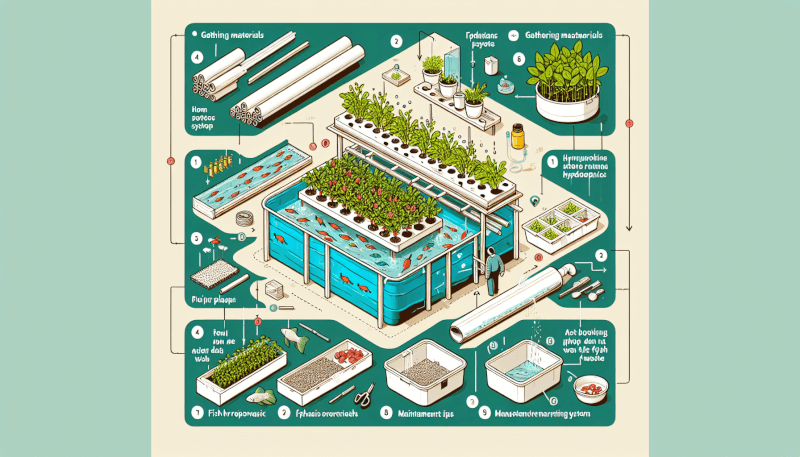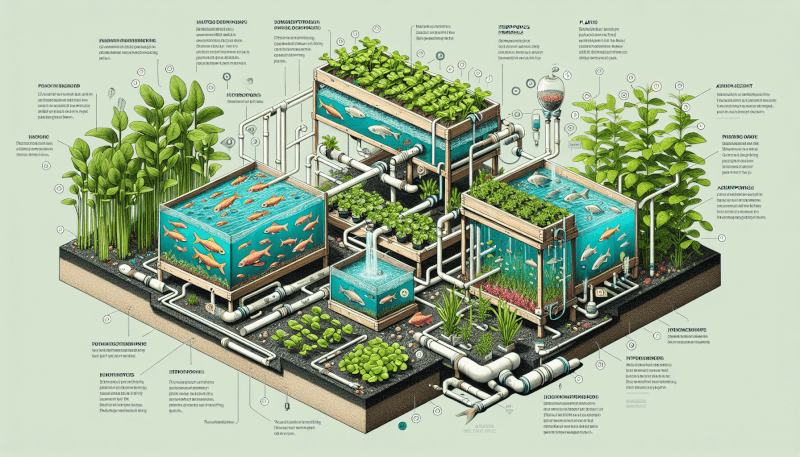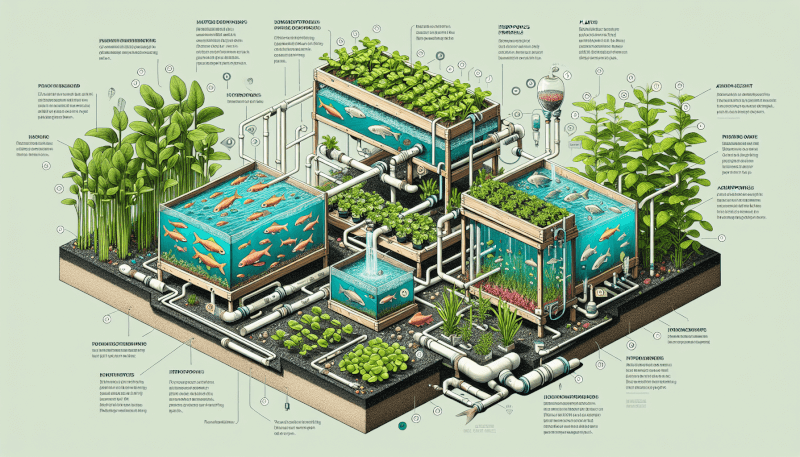So you’ve always wanted to grow your own fresh produce at home, but you’re not quite sure where to start. Look no further than a DIY aquaponics system, which combines the benefits of hydroponics and aquaculture to create a sustainable and efficient method of growing plants. By harnessing the natural symbiotic relationship between fish and plants, you can create a self-sustaining ecosystem that not only yields delicious veggies but also keeps your fish happy and healthy. In this article, we’ll guide you through the step-by-step process of building your very own DIY aquaponics system, so you can start growing your own food and reconnecting with nature right in your backyard.

Choosing the Right Location
When it comes to setting up your DIY aquaponics system, one of the first and most important things to consider is the location. The success of your system greatly depends on the environment it is placed in. Here are some key factors to consider when choosing the right location for your aquaponics system.
Consideration of Climate
The climate of your region plays a crucial role in determining the success of your aquaponics system. Different fish and plant species thrive in different climates, so it’s essential to choose a location that best suits the species you plan to cultivate. Research the ideal temperature, humidity, and sunlight conditions required for your chosen fish and plants and find a location that can provide those conditions.
Availability of Sunlight
Sunlight is a vital component for the growth of your plants. Ensure that the location you choose receives an adequate amount of sunlight throughout the day. A minimum of six hours of direct sunlight is recommended for most plants, although some species may require more. Consider any potential shading from nearby buildings or trees that may obstruct the sunlight and choose a location that allows for maximum sun exposure.
Proximity to a Water Source
Water is the lifeblood of your aquaponics system, so having easy access to a water source is crucial. Look for a location that is near a reliable water source, such as a tap or well. Having quick and convenient access to water will make it easier to maintain the proper water levels in your system and ensure that your fish and plants receive the necessary hydration.
Determining the System Size
The size of your aquaponics system will depend on various factors, such as the available space, your production goals, and your budget. Here are some key considerations to keep in mind when determining the size of your system.
Consideration of Space Available
Evaluate the space you have available for your aquaponics system. Whether you plan to set it up indoors or outdoors, ensure that you have enough room to accommodate the fish tank, grow bed, plumbing, and any additional equipment that may be required. Take measurements and plan accordingly to make the best use of the available space.
Scale of Production
Consider your production goals when determining the size of your aquaponics system. Are you looking to grow a small amount of food for personal use, or do you aim to produce a significant amount for commercial purposes? The scale of production will influence the size of your system and the number of fish and plants it can accommodate. Determine your specific goals and design your system accordingly.
Budget Constraints
Your budget will also play a role in determining the size and complexity of your aquaponics system. While it’s tempting to go all out, it’s important to consider your financial limitations and plan accordingly. Start small and scale up as you gain experience and resources. Keep in mind that while larger systems may have higher upfront costs, they also offer the potential for greater yields in the long run.
Selecting the Fish
Choosing the right fish for your aquaponics system is essential to the overall success of your system. Consider these factors when selecting the fish species for your system.
Researching Fish Species
It’s crucial to research and choose fish species that are well-suited for aquaponics. Tilapia, trout, and catfish are popular choices due to their resilience and ability to thrive in different environments. However, depending on your location and climate, other species may be more suitable. Consider factors such as temperature tolerance, feeding requirements, and growth rates when choosing your fish.
Compatibility with Plants
Different fish species have different nutrient requirements, and their waste will provide the necessary nutrients for your plants. It’s important to select fish that can coexist harmoniously with the plants you plan to grow in your system. Some fish species are more prone to nibbling on plant roots, while others may produce waste that is too rich or toxic for certain plants. Consider the compatibility of fish and plants to ensure a well-balanced aquaponics system.
Relevance to Climate
The fish species you choose should be appropriate for the climate in which your aquaponics system will be located. Certain fish species thrive in warm water, while others prefer cooler temperatures. If your region experiences extreme seasons, it’s essential to choose fish that can adapt and survive in the varying conditions. Research the specific temperature requirements of your chosen fish species and make sure it aligns with your climate.
Choosing the Plants
Selecting the right plants for your aquaponics system is equally important as choosing the right fish. Consider the following factors when deciding on the plant species for your system.
Understanding Plant Needs
Different plants have different growth requirements, including sunlight, water, and temperature. Research the specific needs of the plants you wish to grow and make sure they can thrive in the conditions provided by your aquaponics system. Some plants prefer more shade, while others thrive in direct sunlight. By understanding the unique needs of each plant, you can create an environment that supports healthy growth and maximizes productivity.
Compatibility with Fish
Just as fish species must be compatible with plants, the plants you choose should also be compatible with your fish species. Certain plants serve as natural filters, helping to maintain water quality by absorbing excess nutrients. Additionally, some plants provide hiding places and shade for fish, contributing to their well-being. Consider the symbiotic relationship between fish and plants and select species that will create a beneficial environment for both.
Edible vs. Ornamental Plants
Decide whether you intend to focus on growing edible plants, ornamental plants, or a combination of both. Edible plants, such as lettuce, herbs, and tomatoes, offer the added benefit of a fresh harvest for consumption. On the other hand, ornamental plants, such as flowers or decorative foliage, can enhance the aesthetics of your aquaponics system. Consider your personal preferences and goals when choosing between edible and ornamental plants.

Deciding on the System Design
Aquaponics systems come in various designs, each with its unique advantages and challenges. Consider these three common system designs when deciding on the layout for your DIY system.
Media-based System
In a media-based aquaponics system, plants are grown in a bed filled with a growing medium like expanded clay pellets or gravel. The media acts as both a support structure for the plants and a biofilter for the beneficial bacteria that convert fish waste into nutrients for the plants. Media-based systems offer excellent plant support and allow for a variety of plant types to be grown.
Nutrient Film Technique (NFT)
Nutrient Film Technique (NFT) systems are popular for their simple design and efficient use of water and nutrients. In an NFT system, a thin film of nutrient-rich water flows over the roots of the plants, providing them with the necessary nutrients. This continuous flow system requires careful monitoring and balance to ensure optimal nutrient delivery to the plants.
Deep Water Culture (DWC)
Deep Water Culture (DWC) systems involve suspending plant roots directly in a nutrient-rich water solution. The plants receive oxygen through the use of air stones or diffusers, which release bubbles into the water. DWC systems are relatively easy to set up and maintain, making them suitable for beginners. However, they may require additional equipment for aeration and control of water temperature.
Gathering the Equipment
To build your DIY aquaponics system, you’ll need a range of equipment. Here’s a list of essential items to gather before setting up your system.
Fish Tank
Select a fish tank that is appropriate for the size of your system and the number of fish you plan to cultivate. Consider the material of the tank, ensuring it is sturdy and non-toxic. Common options include fiberglass, plastic, or food-grade containers.
Grow Bed
Choose a suitable grow bed that can accommodate the plant species you intend to grow. It should be the appropriate size, made of non-toxic materials, and have adequate drainage and filtration capabilities.
Pump
A reliable water pump is necessary to circulate water between the fish tank and the grow bed. Ensure that the pump is powerful enough to maintain a steady flow of water.
Air Stones
Air stones or diffusers are essential for providing oxygen to the fish and maintaining a healthy aquatic environment. Place the air stones strategically in the fish tank to ensure proper oxygenation.
Tubing
High-quality tubing is required to connect various components of the aquaponics system, such as the pump, air stones, and plumbing. Choose tubing that is durable and the appropriate size for your system.
Filtration System
Consider installing a filtration system to remove any solid waste or excess nutrients from the water. Options include mechanical, biological, or integrated filtration systems, which contribute to better water quality and overall system health.
Water Heater (if needed)
If your aquaponics system will be located in an area with cold temperatures, you may need a water heater to maintain an optimal water temperature for the fish. Ensure that the heater is suitable for the size of your system and can maintain the desired temperature range.
Monitoring Equipment
To maintain optimal conditions within your aquaponics system, monitoring equipment is crucial. Invest in a reliable pH meter, thermometer, and water testing kit to regularly monitor the water quality and make any necessary adjustments.

Setting up the Fish Tank
Setting up the fish tank is a vital step in creating a healthy and thriving aquaponics system. Follow these steps to ensure a successful fish tank setup.
Ensuring Proper Size and Material
Choose a fish tank that provides an adequate habitat for your chosen fish species. Consider factors such as the fish’s size, growth rate, and social behavior. Additionally, ensure that the tank material is non-toxic and capable of withstanding the weight and pressure of the water.
Installing the Aeration System
Proper aeration is essential for maintaining oxygen levels in the fish tank. Install air stones or diffusers at strategic locations in the tank to achieve optimal oxygenation. Connect the air stones to an air pump that will continuously supply air to the tank.
Adding Water
Fill the fish tank with water, taking care to dechlorinate it if necessary. Chlorine and other chemicals present in tap water can be harmful to fish. Allow the water to reach the desired temperature and let it sit for a few days to stabilize before adding fish.
Establishing Biofiltration
Biofiltration is crucial for maintaining water quality in your aquaponics system. Introduce beneficial bacteria to the fish tank to kickstart the nitrogen cycle. This bacteria will convert toxic ammonia from fish waste into less harmful nitrates, which will serve as nutrients for the plants. You can source beneficial bacteria from existing aquariums or purchase them from a reputable supplier.
Setting up the Grow Bed
The grow bed is where your plants will grow and receive nutrients from the fish waste. Here’s how to set it up effectively.
Choosing the Suitable Grow Media
Select a suitable grow media to support the plants and foster beneficial bacterial growth. Common options include expanded clay pellets, gravel, or coconut coir. Ensure that the grow media is clean, pH-neutral, and non-toxic to both fish and plants.
Positioning of Grow Bed
Place the grow bed in a location that allows easy access for maintenance and harvesting. Ensure that it is properly supported and level to prevent any instability. Consider the weight of the grow bed when choosing its location.
Installing the Plumbing
Connect the plumbing system between the fish tank and the grow bed. This will allow nutrient-rich water to flow from the fish tank to the grow bed and back. Ensure that the plumbing is secure, fully sealed, and appropriately sized for your system.
Adding Plant Seeds or Seedlings
Once the plumbing is in place, it’s time to add your chosen plants to the grow bed. You can start from seeds or use seedlings, depending on your preference and experience level. Follow the specific planting instructions for each plant and make sure they are properly spaced to allow optimal growth.

Setting up the Plumbing
Properly setting up the plumbing connections between the fish tank and the grow bed is essential for the smooth operation of your aquaponics system.
Connecting the Fish Tank and Grow Bed
With the help of tubing and appropriate connectors, establish a continuous flow of water between the fish tank and the grow bed. Consider the height and positioning of the grow bed relative to the fish tank to ensure proper water flow.
Integrating Pump and Air Stones
Connect the water pump to the plumbing system to facilitate the circulation of water. Ensure that the pump is properly positioned and securely fastened to prevent any movement or leaks. Connect the air stones or diffusers to the fish tank to ensure sufficient aeration.
Adding Drainage Pipes or Tubes
To maintain appropriate water levels in the grow bed, install drainage pipes or tubes. This will allow excess water to flow back to the fish tank, preventing waterlogging in the grow bed. Position the drainage system in such a way that it efficiently removes excess water without damaging the plants.
Checking for Leaks
Once the plumbing connections are complete, thoroughly check for any leaks in the system. Leaks can disrupt the water flow and compromise the overall health of your aquaponics system. Use a bucket or basin to collect water from the various components and ensure that everything is watertight.
Maintaining the Aquaponics System
Proper maintenance is essential to keep your aquaponics system running smoothly. Here are some key tasks to perform regularly to maintain the health and productivity of your system.
Feeding and Monitoring Fish
Regularly feed your fish a balanced diet suitable for their species. Monitor their behavior and health, and make adjustments to their feeding regimen as needed. Keep a close eye on their waste production and ensure that it is being effectively converted into nutrients for the plants.
Managing Plant Growth
Regularly check and prune your plants to maintain optimal growth and prevent overcrowding. Remove any dead or yellowing leaves, and trim plants to promote airflow and light penetration. Monitor plants for signs of nutrient deficiencies or pest infestations and take appropriate action.
Regular System Inspections
Conduct regular inspections of your aquaponics system to check for any signs of malfunction or imbalance. Look for clogged pipes, leaks, or any issues with the plumbing or equipment. Regular inspections will help catch and address problems early, preventing further damage to the system.
Maintaining Water Quality
Regularly test the water parameters, including pH, ammonia, nitrite, and nitrate levels. Adjust as necessary to maintain optimal conditions for both fish and plants. Perform partial water changes to maintain a healthy balance and prevent the buildup of harmful compounds. Regularly clean the filters and remove any debris or excess waste from the system.
In conclusion, building your own DIY aquaponics system requires careful consideration of various factors, including location, system size, fish and plant selection, system design, and equipment. By following the steps outlined in this article, you can create a thriving aquaponics system that provides you with a sustainable source of fresh fish and vegetables in a friendly and environmentally-friendly manner. Happy aquaponics gardening!



